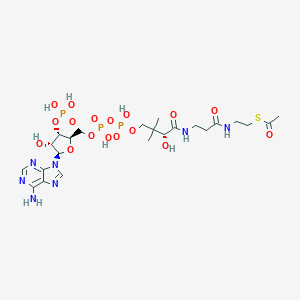Details of Metabolite
| Full List of Protein(s) Regulating This Metabolite | ||||||
|---|---|---|---|---|---|---|
| Lyases (EC 4) | ||||||
| Ethylmalonyl-CoA decarboxylase (ECHDC1) | Click to Show/Hide the Full List of Regulating Pair(s): 1 Pair(s) | |||||
| Detailed Information |
Protein Info
 click to show the details of this protein click to show the details of this protein
|
|||||
| Regulating Pair |
Experim Info
 click to show the details of experiment for validating this pair click to show the details of experiment for validating this pair
|
[1] | ||||
| Introduced Variation | Overexpression of Echdc1 | |||||
| Induced Change | Acetyl-CoA concentration: increase | |||||
| Summary | Introduced Variation
|
|||||
| Disease Status | Healthy individual | |||||
| Details | It is reported that overexpression of Echdc1 leads to the increase of acetyl-CoA levels compared with control group. | |||||
| Oxidoreductases (EC 1) | ||||||
| Alcohol dehydrogenase iron 1 (ADHFE1) | Click to Show/Hide the Full List of Regulating Pair(s): 1 Pair(s) | |||||
| Detailed Information |
Protein Info
 click to show the details of this protein click to show the details of this protein
|
|||||
| Regulating Pair |
Experim Info
 click to show the details of experiment for validating this pair click to show the details of experiment for validating this pair
|
[2] | ||||
| Introduced Variation | Overexpression of ADHFE1 | |||||
| Induced Change | Acetyl-CoA concentration: increase | |||||
| Summary | Introduced Variation
|
|||||
| Disease Status | Breast cancer [ICD-11: 2C60] | |||||
| Details | It is reported that overexpression of ADHFE1 leads to the increase of acetyl-CoA levels compared with control group. | |||||
| Glutamate-cysteine ligase modifier (GCLM) | Click to Show/Hide the Full List of Regulating Pair(s): 1 Pair(s) | |||||
| Detailed Information |
Protein Info
 click to show the details of this protein click to show the details of this protein
|
|||||
| Regulating Pair |
Experim Info
 click to show the details of experiment for validating this pair click to show the details of experiment for validating this pair
|
[3] | ||||
| Introduced Variation | Knockout of Gclm | |||||
| Induced Change | Acetyl-CoA concentration: increase (FC = 1.60) | |||||
| Summary | Introduced Variation
|
|||||
| Disease Status | Metabolic liver disease [ICD-11: 5C90] | |||||
| Details | It is reported that knockout of Gclm leads to the increase of acetyl-CoA levels compared with control group. | |||||
| Pore-forming PNC peptide (PNC) | ||||||
| Cellular tumor antigen p53 (TP53) | Click to Show/Hide the Full List of Regulating Pair(s): 1 Pair(s) | |||||
| Detailed Information |
Protein Info
 click to show the details of this protein click to show the details of this protein
|
|||||
| Regulating Pair |
Experim Info
 click to show the details of experiment for validating this pair click to show the details of experiment for validating this pair
|
[4] | ||||
| Introduced Variation | Knockout of TP53 | |||||
| Induced Change | Acetyl-CoA concentration: decrease (Log2 FC=0.72) | |||||
| Summary | Introduced Variation
|
|||||
| Disease Status | Colon cancer [ICD-11: 2B90] | |||||
| Details | It is reported that knockout of TP53 leads to the decrease of acetyl-CoA levels compared with control group. | |||||
| Transferases (EC 2) | ||||||
| Transaldolase (TALDO1) | Click to Show/Hide the Full List of Regulating Pair(s): 1 Pair(s) | |||||
| Detailed Information |
Protein Info
 click to show the details of this protein click to show the details of this protein
|
|||||
| Regulating Pair |
Experim Info
 click to show the details of experiment for validating this pair click to show the details of experiment for validating this pair
|
[5] | ||||
| Introduced Variation | Knockout of Taldo1 | |||||
| Induced Change | Acetyl-CoA concentration: increase | |||||
| Summary | Introduced Variation
|
|||||
| Disease Status | Healthy individual | |||||
| Details | It is reported that knockout of Taldo1 leads to the increase of acetyl-CoA levels compared with control group. | |||||
If you find any error in data or bug in web service, please kindly report it to Dr. Zhang and Dr. Mou.

